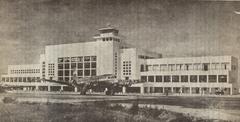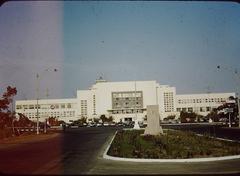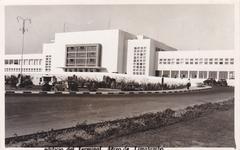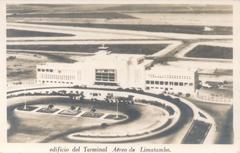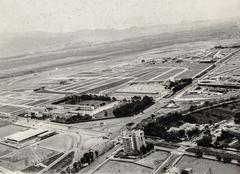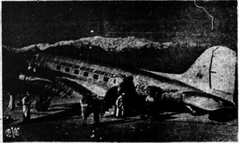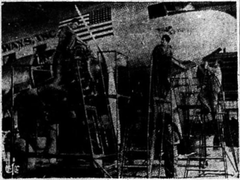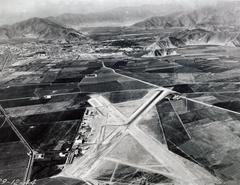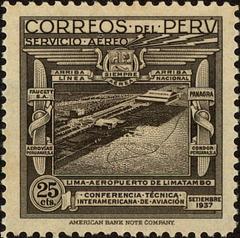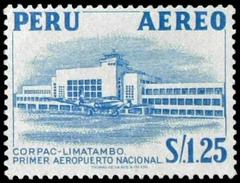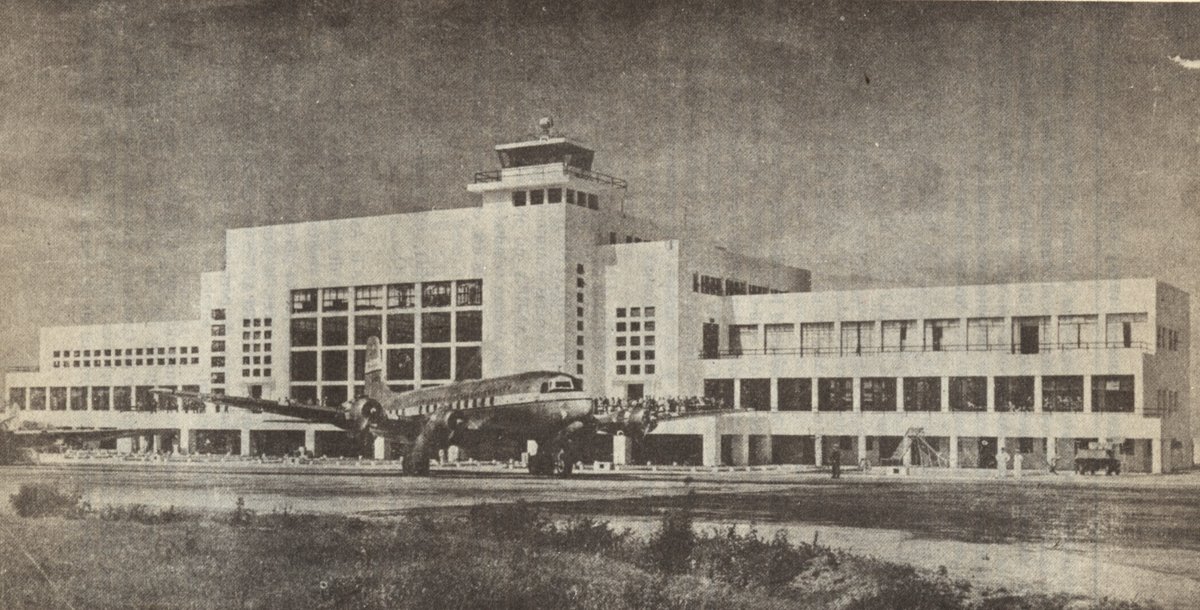
Limatambo International Airport Visiting Guide: Lima, Peru – Tickets, Hours, and Travel Tips
Date: 14/06/2025
Introduction: Limatambo International Airport – History and Legacy
Limatambo International Airport is a cornerstone of Lima’s aviation heritage, symbolizing Peru’s early ambitions to modernize and integrate into the global aviation network. Established in 1934 in the San Isidro district, Limatambo was Lima’s first major international airport and played a critical role in connecting Peru domestically and internationally. The airport’s story traces the city’s transformation from a mid-20th-century urban center to the thriving metropolis it is today.
Although Limatambo ceased operations in the early 1970s, its legacy lives on through preserved architecture and the repurposing of its grounds for government and urban uses. Today, the site provides a unique lens into Peru’s aviation history for visitors interested in urban development and historical milestones.
This guide explores Limatambo’s origins, architectural highlights, pivotal moments, and practical information for travelers seeking to experience Lima’s aviation legacy—alongside tips for visiting the site and nearby attractions. For more on Lima’s travel tips and airport history, refer to My Adventures Across the World, Wikipedia, and LimaEasy.
Contents
- Introduction
- Limatambo’s Origins and Development
- Role in Peruvian Aviation History
- Architectural and Technological Innovations
- Historic Events and Milestones
- Decline and Transition to Jorge Chávez Airport
- Limatambo’s Legacy and Current Status
- Visiting Limatambo Today
- Access and Hours
- Getting There
- Nearby Attractions
- Travel Tips
- Visual Resources
- FAQs
- Related Articles
- Conclusion
Limatambo’s Origins and Early Development
Inaugurated in 1934, Limatambo International Airport—Aeropuerto Internacional de Limatambo—was conceived during a period of rapid modernization in Peru. The airport’s location near Lima’s center, in San Isidro, allowed easy access for travelers and government officials alike. Facilities included a paved runway, a terminal with Art Deco influences, and advanced navigation aids for the era. Limatambo quickly became a symbol of progress, welcoming both Peruvian and international airlines as the city’s air travel hub.
Role in Peruvian Aviation History
Limatambo was vital in shaping Peru’s commercial aviation. From the 1930s to the 1960s, it was the main base for key airlines such as Compañía de Aviación Faucett and Aeroperú, facilitating routes across South America, North America, and Europe. Its strategic location made it a key Pacific stopover for military and commercial aircraft during World War II, prompting expansion and modernization of its facilities.
By the 1950s, Limatambo was at the heart of Peru’s growing aviation sector, handling a rising volume of passengers and cargo. The airport was instrumental in integrating the country into international trade and tourism networks.
Architectural and Technological Innovations
Limatambo’s terminal showcased streamlined Art Deco design and functionality. The control tower, among the region’s earliest, introduced advanced radio communications and, later, night lighting systems—pioneering features that enabled 24-hour operations. The single runway, initially 2,000 meters, was lengthened over time to accommodate evolving aircraft technology.
Historic Events and Milestones
Limatambo hosted numerous historic moments, receiving dignitaries, celebrities, and heads of state. Airlines such as Pan American World Airways and Braniff International Airways launched routes from the airport, underscoring its international importance.
The airport played a crucial role in disaster response, notably during the 1970 Ancash earthquake, when it facilitated the arrival of international aid. Limatambo also witnessed the advent of jet travel in Peru with the arrival of the first commercial jetliners.
Decline and Transition to Jorge Chávez International Airport
By the late 1960s, Limatambo’s location within an expanding urban area and limited room for growth necessitated a new, larger airport. The opening of Jorge Chávez International Airport in Callao in 1965 marked the beginning of Limatambo’s gradual decommissioning (My Adventures Across the World). Commercial flights shifted to the new facility, and Limatambo ceased operations as the city’s primary airport in the early 1970s.
Limatambo’s Legacy and Current Status
Today, the former terminal and control tower, repurposed as the headquarters of the Ministry of the Interior, stand as architectural landmarks. The site—locally known as “El Pentagonito”—anchors a government complex, while the original runways now form Avenida Guardia Civil and Avenida José Gálvez Barrenechea, major city avenues. Street names and local references preserve the memory of the airport’s past.
Though aviation activities are long gone, the district’s mid-century character and urban layout offer visitors a glimpse into Lima’s historical evolution (Wikipedia).
Visiting Limatambo Today
Access and Hours
- Site Access: The public can explore the area surrounding the former airport, including parks and avenues, during regular daytime hours.
- Terminal Building: Now a government office, the terminal is not open to the public.
Getting There
- Location: San Isidro district, approximately 5 km from downtown Lima.
- Transport: Reachable by taxi, rideshare app, or public buses; nearby metro stations offer additional access. Note that traffic in Lima can be dense during peak hours (Lonely Planet).
Nearby Attractions
- San Isidro Financial District: Modern skyscrapers, shops, and dining.
- Parque El Olivar: A historic olive grove park, ideal for walks.
- Huaca Huallamarca: Pre-Columbian pyramid and museum.
- Miraflores (nearby): Includes Parque Kennedy and the Huaca Pucllana archaeological site.
Travel Tips
- Footwear: Wear comfortable walking shoes; much of the area is best explored on foot.
- Weather: Early mornings or late afternoons are most pleasant.
- Security: San Isidro is generally safe, but normal urban precautions apply.
- No Tickets Required: The area is open; government buildings are not accessible.
Visual Resources
- Images: Seek out historical photos of Limatambo’s terminal building, vintage aircraft, and maps indicating the site’s location within Lima.
- Virtual Tours: Online archives and local museums may offer virtual or photographic tours of Lima’s aviation past.
Frequently Asked Questions (FAQ)
Q: Can I visit the original Limatambo Airport facilities?
A: No, the former terminal is a government office and not open to the public, but the surrounding avenues and landmarks are accessible.
Q: How do I get to the Limatambo site from central Lima?
A: Taxi, rideshare, or public transportation will get you to San Isidro in about 10–15 minutes from the city center.
Q: Are there aviation-themed tours in Lima?
A: While no tours focus solely on Limatambo, some historical walking tours cover the area’s aviation heritage.
Q: What are other nearby sites of interest?
A: San Isidro’s parks, Huaca Huallamarca, and Miraflores’ cultural attractions are all close by.
Related Articles
Conclusion
Limatambo International Airport represents a pivotal chapter in Lima’s and Peru’s aviation history. Although the airport itself no longer serves its original function, the area’s architecture, street names, and urban layout preserve an important legacy. Exploring the district offers a unique perspective on Lima’s journey from a regional hub to a bustling modern city.
Travelers interested in history and urban evolution will find the Limatambo site and its surroundings rewarding. For updates on Lima’s historical attractions and travel tips, consider downloading the Audiala app or consulting reputable travel guides and official resources.
Image Suggestions:
- Historical terminal building (“Limatambo International Airport historical terminal”)
- Aerial map of original airport site in San Isidro
- Photos of Avenida Guardia Civil tracing the former runway
External Links:
- My Adventures Across the World - Visiting Lima Travel Tips
- Peruvian Ministry of Transport and Communications
Internal Links:
- Related articles listed above
Exploring Jorge Chávez International Airport: Hours, Tickets, and Lima’s Historical Sites
Introduction
Jorge Chávez International Airport succeeded Limatambo as Lima’s primary gateway, reflecting the city’s growing importance in regional and global aviation. This section covers the airport’s evolution, visitor logistics, and nearby attractions.
From Limatambo to Jorge Chávez: Aviation’s Turning Point
The transition from Limatambo to Jorge Chávez marked Lima’s shift to modern aviation. The new airport, located in Callao, opened in 1965 with longer runways and state-of-the-art facilities, accommodating increasing passenger and cargo demands (Wikipedia).
Airport Facilities and Expansion
Jorge Chávez International Airport now manages over 22.8 million passengers annually, serving as a hub for LATAM Perú and Sky Airline. Ongoing expansions include a new terminal (opening June 2025), a second runway, and advanced navigation systems (Fraport), all designed to position Lima as a South American aviation leader (Airports Worldwide).
Economic and Urban Impact
The airport community contributes over US$1.4 billion to Peru’s GDP and supports thousands of jobs (GTR Magazine). The new “airport city” concept will add business centers, hotels, and logistics hubs, integrating seamlessly with Lima’s urban infrastructure (International Airport Review).
Passenger and Visitor Information
- Hours: Open 24/7. Terminal access follows flight schedules.
- Ticketing: Purchase via airlines, agencies, or official platforms.
- Accessibility: Comprehensive services for passengers with reduced mobility.
- Transport: Taxis, shuttle buses, and improved highway/metro connectivity.
Nearby Attractions
- Plaza Mayor (Plaza de Armas): Lima’s historic heart with colonial landmarks.
- Larco Museum: Premier collection of pre-Columbian art.
- Miraflores District: Parks, shopping, and coastal views.
Guided tours are available through local operators and the airport’s information center.
Awards and Innovations
Jorge Chávez Airport has received multiple accolades for passenger experience and innovation (Fraport). The ongoing “airport city” development further cements its status as a regional aviation hub.
Plaza Mayor of Lima: Key Visitor Information
As Lima’s historic and cultural center, Plaza Mayor (Plaza de Armas) is surrounded by architectural and historical marvels:
- Accessibility: Open 24/7, free of charge.
- Cathedral of Lima: 9:00 AM – 6:30 PM, ~15 PEN entry.
- Government Palace: Open for guided entry; advance booking required.
- Archbishop’s Palace: 10:00 AM – 5:00 PM, ~10 PEN entry.
Photography, guided tours, and English-speaking options are widely available. For up-to-date schedules and events, check official websites: Official Lima Tourism Website, Cathedral of Lima.
Summary of Key Points and Final Tips
Limatambo International Airport’s story illustrates Lima’s evolution in aviation and urban development. Its transformation from a bustling airport to a government and urban complex reflects the city’s adaptive reuse of historical infrastructure. Nearby, Jorge Chávez International Airport continues this legacy, positioning Lima as a major South American hub. While Limatambo itself is not open to the public, its surrounding avenues, architecture, and proximity to cultural sites offer a unique urban narrative.
For deeper exploration and travel planning, leverage resources like the Peruvian Ministry of Transport and Communications and Lonely Planet. Download the Audiala app for the latest updates and curated travel guides.
Sources and Further Reading
- My Adventures Across the World – Visiting Lima Travel Tips
- Jorge Chávez International Airport – Wikipedia
- Limatambo International Airport – Wikipedia
- LimaEasy – The Lima International Airport (Jorge Chavez)
- InsideInside – Limatambo International Airport
- Lonely Planet – Things to Know Before Traveling to Lima
- GTR Magazine – Lima Airport Partners to Introduce Airport City
- International Airport Review – Lima as South America’s New Airport City
- Fraport – Lima International Airport
- Airports Worldwide – Jorge Chavez Intl Peru
- Nomadic Matt – Peru Travel Tips
